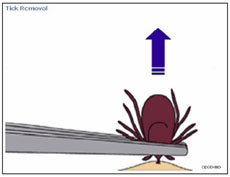
Blacklegged ticks (also called deer ticks) may carry tick-borne diseases including anaplasmosis, babesiosis, Powassan virus infection and/or Lyme disease. Tick-borne diseases can spread to people by a tick bite from an infected blacklegged tick and may cause potentially serious infections. The best way to avoid tick-borne diseases is to avoid tick bites.
Blacklegged ticks are small, ranging in size from a poppy seed (less than 2 mm) to a pea (5 mm). The size of the tick varies depending on its life stage (larva, nymph, adult) and whether it has fed recently. The nymphal stage typically occurs during the summer months and is the stage most responsible for human infections. This is due to their very small size (less than 2 mm) which prevents people form noticing them on their body. Adult ticks are larger (5 mm) and therefore more likely to be discovered and removed before they have had time to transmit bacteria, viruses and/or parasites.
Ticks cannot fly or jump. Instead, they exhibit behaviour called questing, where they wait for a host (person, animal or bird), resting on the tips of grasses, leaves and shrubs. If a person brushes the spot where a tick is waiting, it quickly climbs aboard. It then finds a suitable place to bite. Ticks can attach to any part of the human body but prefer warm, moist areas and if found, may be in hard-to-see areas such as the armpits, groin and scalp.
Ticks are most active in spring and summer but can be found at any time of the year when the temperature is above freezing.
Ticks are found in wooded or brushy areas with lots of leaves on the ground or where there are tall grasses. Blacklegged ticks are not usually found on lawns, mowed grass, sports fields or paved areas; however, tick prevention measures should always be taken when outdoors.
Blacklegged ticks have been found in Toronto and are established here. All of Toronto is considered an Established Risk Area. Established Risk Areas are locations where blacklegged ticks will occur regularly from year to year and where humans have the potential to come into contact with infective ticks.
The risk of acquiring tick-borne diseases in Toronto overall is believed to be low. However, the risk for exposure is highest in wooded, brushy areas where blacklegged tick populations are established. Personal protective measures should be taken when visiting these areas.
Toronto’s active tick surveillance program drags sites that are newly established or where blacklegged ticks have been found in previous years, monitors the number of blacklegged ticks in the surveillance location, and the number of them that carry the bacteria, viruses and/or parasites that cause tick-borne diseases. Residents should take the same personal protective measures in any area of the City as all of Toronto is considered an Established Risk Area.
The best way to prevent tick-borne diseases is to avoid tick bites.
How to avoid tick bites:
If you find a tick on your body, it can be removed with fine-tipped tweezers. Do not squeeze or try to burn it off.

If you develop a rash or fever within several weeks of removing a tick, see your doctor. Be sure to tell the doctor about your recent tick bite, when the bite occurred, and where you most likely acquired the tick.
An electronic tick identification platform is now available in Ontario, where anyone who finds a tick can submit a photo of the tick and receive species identification results within 48 hours. This free publicly available tick identification platform can be used for ticks found on a person, pet or in the environment.